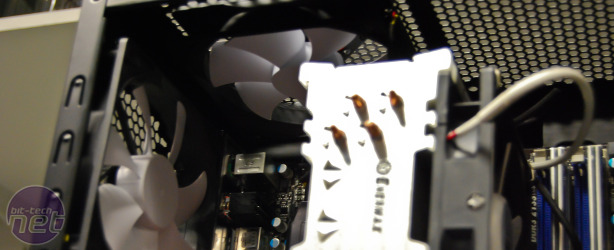
Cooling with Three Fans
Adding a third fan into the mix gives us another solid drop in temperatures shaving a solid 2-4oC off the results across the board. This meant that we were now seeing CPU and GPU results in the 46-52oC range, rather than the 50-54oC bracket that we observed with two fans mounted inside the case.It’s worth noting that this doesn’t mean that three fans are always better than two however - some of the three fan setups actually returned poorer results than the best of the two fan arrangements. Evidently the world of cooling is a little more complex than more = better.
The graph below shows that the side panel fan still continues to have a massive positive effect on cooling, even with three fans installed - the three setups that performed the best in this test all included a side panel fan. They also all included either a roof or rear exhaust fan, which couples up well with our findings from out two fan testing that these mounts work well together.
Interestingly we’re also starting to see how various other fan mounts link up to provide effective cooling. What we’re talking about here is the front intakes - fill them both and add an exhaust and the results are disappointing, the front intakes just don’t seem to be able to push air fan enough through the case to form an effective air stream with the rear exhaust. Replace one of the front intakes with a side panel fan though and things are a different story - CPU, GPU and chipset temperatures dropped by 3oC, 1oC and 8oC respectively.
This is interesting as the fundamental setup remains the same (two intakes, one exhaust), indeed two of the fans are in identical positions. The benefits of the side panel fan are twofold though. Firstly, it provides airflow in an important area of the case and secondly, it helps to push the air pulled in by the front intake through the case - effectively it bridges the gap between the front and rear fans. It’s a delicate balance though as the Front (L), Roof (B), Floor setup didn’t perform nearly as well, despite being relatively similar.
One other thing we tried at this stage was seeing what effect blanking up all unused fan mounts would have on cooling. We wanted to try this because we’ve talked before about the disadvantages that can arise from having too many vents or open mounts in a case can cause, namely that the airflow lacks focus and can get a little ‘lost’ inside a case with too much venting - the Antec LanBoy Air is the best example of this.
To do this test we arranged the three fans in probably the most traditional three fan setup (two front intakes, one rear exhaust) and tested with all the remaining fan mounts open and closed. The results surprised us a little as we thought that focusing the air flow provided by the two front intakes like this would make the setup perform better. We were wrong however as adding the blanking plates raised all three of the temperatures we were measuring. It was only by a little however, and adding the plates did cut down the noise emitted by the case considerably, so this is worth doing if you don’t mind a small hit in temperatures for a big noise reduction gain.
We’d also just like to draw your attention to the chipset temperatures on show here too. There was an 11oC difference between the best and worst performing setups here and that’s massive - especially over a long period of time. Modern motherboards are way more resilient than their predecessors but the components on them still have a limited life span and this is only going to be shortened if the components run at warmer temperatures than they need to.

MSI MPG Velox 100R Chassis Review
October 14 2021 | 15:04









Want to comment? Please log in.